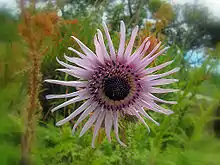| Berkheya purpurea | |
|---|---|
 | |
| Scientific classification | |
| Kingdom: | Plantae |
| Clade: | Tracheophytes |
| Clade: | Angiosperms |
| Clade: | Eudicots |
| Clade: | Asterids |
| Order: | Asterales |
| Family: | Asteraceae |
| Genus: | Berkheya |
| Species: | B. purpurea |
| Binomial name | |
| Berkheya purpurea | |
Berkheya purpurea (syn. Stobaea purpurea DC.), also known as purple berkheya, is a member of the daisy family (Asteraceae) of flowering plants. Like most members of its genus, Berkheya, it is native to southern Africa.
Description
This herbaceous perennial grows to a height of 75 cm (30 in). It has a 90 cm (35 in) rosette of spiky leaves, each leaf being 45 cm (18 in) in length and 10 cm (3.9 in) broad. The leaves have a white felted underside. From the centre of each rosette grows a stem with 8 cm (3.1 in) successional flowers on side branches. The daisy-like composite blooms have white or pale mauve ray florets surrounding a central head of darker purple. It flowers in summer.[1]
Distribution
This plant is native to Lesotho and South Africa (in Eastern Cape, Free State, KwaZulu-Natal and Northern Cape).[2]
Cultivation
Berkheya purpurea is hardy to −10 °C (14 °F), but requires a sheltered position in full sun, with moist but well-drained soil.[1]
References
- 1 2 "Berkheya purpurea". www.rhs.org. Royal Horticultural Society. Retrieved 20 July 2023.
- ↑ "Berkheya purpurea". Germplasm Resources Information Network. Agricultural Research Service, United States Department of Agriculture.
- Pink, A. (2004). Gardening for the Million. Project Gutenberg Literary Archive Foundation.
- Karis, Per Ola (2006). "Morphological data indicates two major clades of the subtribe Gorteriinae (Asteraceae-Arctotideae)". Cladistics. Blackwell Publishing. 22 (3): 199–221. doi:10.1111/j.1096-0031.2006.00109.x.
External links
- Berkheya purpurea Archived 2017-04-24 at the Wayback Machine